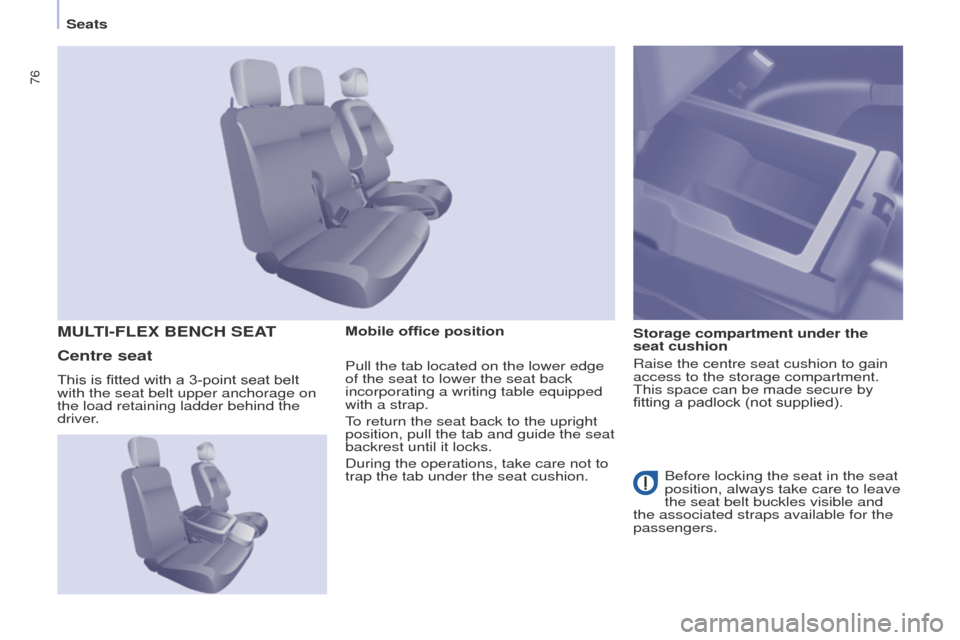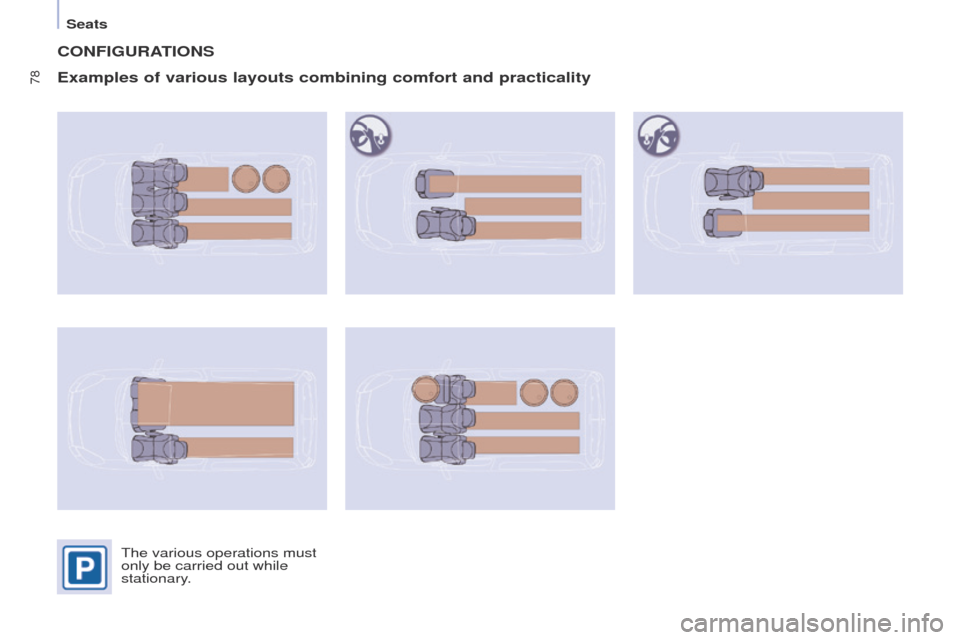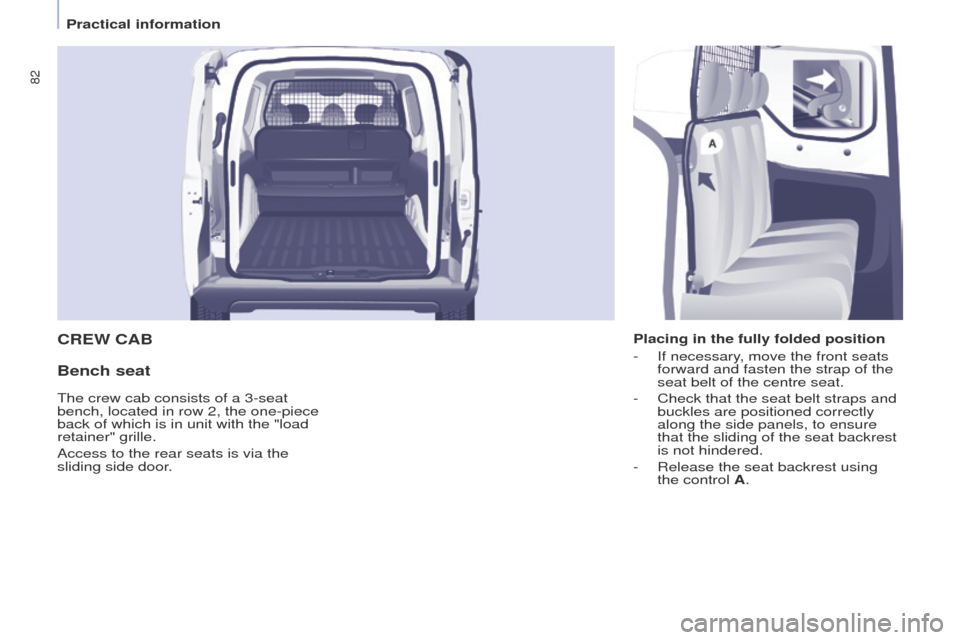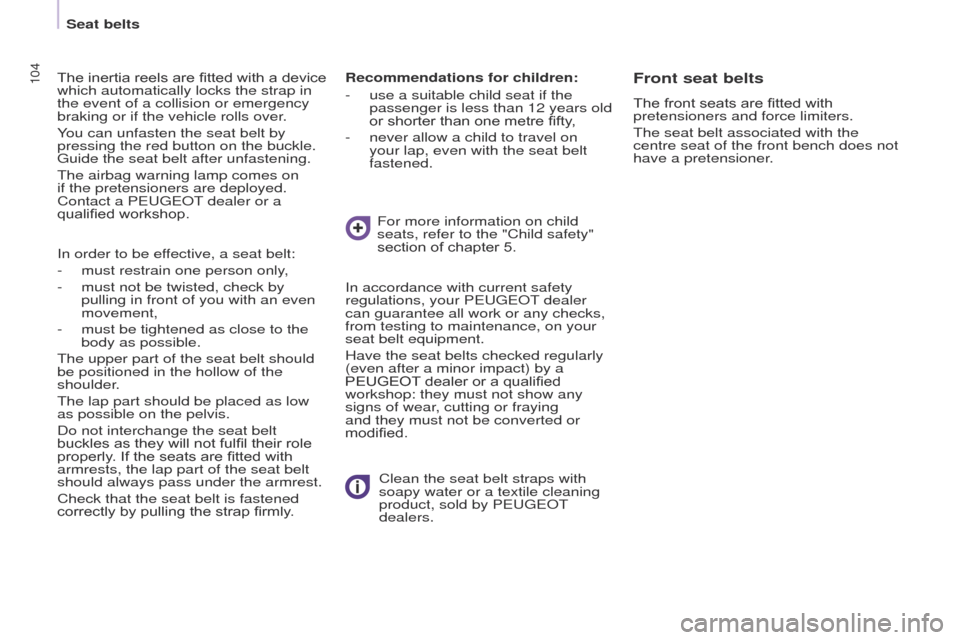2017 Peugeot Partner seats
[x] Cancel search: seatsPage 78 of 260

76
Partner-2-VU_en_Chap04_Ergonomie_ed02-2016
SeatsMobile office position Storage compartment under the
seat cushion
Raise the centre seat cushion to gain
access to the storage compartment.
This space can be made secure by
fitting a padlock (not supplied).
MULTI-FLEx BENCH SEAT
Centre seat
Before locking the seat in the seat
position, always take care to leave
the seat belt buckles visible and
the associated straps available for the
passengers.
This is fitted with a 3-point seat belt
with the seat belt upper anchorage on
the load retaining ladder behind the
driver.
Pull the tab located on the lower edge
of the seat to lower the seat back
incorporating a writing table equipped
with a strap.
To return the seat back to the upright
position, pull the tab and guide the seat
backrest until it locks.
During the operations, take care not to
trap the tab under the seat cushion.
Page 79 of 260

77
Partner-2-VU_en_Chap04_Ergonomie_ed02-2016
Seats
Foldaway position
Outer seatFully folded position
The backrest of the outer seat has a
metal shell. Pull the tab located on the upper edge
of the seat by the head restraint to tilt
and guide the entire seat.
It inserts itself into the floor in the
front seat position and so forms a
continuous flat floor with the load
space.
This position allows long loads to be
carried inside the vehicle, up to 3 m
(3.25 m in the case of the long versions)
with the doors closed.
In the fully folded position, the maximum
weight on the seat backrest is 50 kg.
To return the seat to the seat position,
raise the seat backrest until it locks on
the floor in the seat position. Raise the yellow lever located at the
base of the seat to release and raise
the entire seat to the foldaway position
(seat cushion raised against the seat
backrest) until it locks.
This position allows tall loads to be
carried in the cab part.
To return the seat to the seat position,
push the yellow lever located under the
seat cushion and lower the entire seat
until it is upright and locked on the floor
in the seat position.
EASE OF USE and COMFORT
4
Page 80 of 260

78
Partner-2-VU_en_Chap04_Ergonomie_ed02-2016
Seats
CONFIGURATIONS
Examples of various layouts combining comfort and practicality
The various operations must
only be carried out while
stationary.
Page 82 of 260

80
Partner-2-VU_en_Chap04_Ergonomie_ed02-2016
Overhead storage unit
This is located above the sun visors
and can accommodate various objects
(a jumper, file, gloves...).
The openings concealed by the sun
visors allow you to see and access the
objects stored in the overhead storage
unit.
The maximum weight permitted in the
overhead storage unit is 5 Kg.
Do not place objects in this storage
unit which could present a risk to the
occupants.
Central storage console
This console offers an appreciable
additional storage area: it can be
removed and clips onto a base which
also incorporates two cup holders at
the rear.
Ensure that the object (bottle, can...)
placed in the cup holder is retained
securely and does not risk being
dislodged while driving.
Any liquid which could spill presents
a risk of damage on contact with the
instrument panel and centre console
controls.
Take care.
Sun visor
To prevent dazzle from ahead, fold the
sun visor down.
A pocket is provided in the driver's sun
visor for storing toll cards, tickets, ...
Storage compartments under seats
Storage compartments may be
provided in the floor under the front
seats.
Move the seat forward for easier
access to the storage compartment.
The vehicle's tools are located here.
For more information on these
tools, refer to chapter
9, "Changing
a wheel" section.
Practical information
Page 84 of 260

82
Partner-2-VU_en_Chap04_Ergonomie_ed02-2016
CREW CAB
Bench seat
Placing in the fully folded position
-
If necessary
, move the front seats
forward and fasten the strap of the
seat belt of the centre seat.
-
Check that the seat belt straps and
buckles are positioned correctly
along the side panels, to ensure
that the sliding of the seat backrest
is not hindered.
-
Release the seat backrest using
the control
A.
The crew cab consists of a 3-seat
bench, located in row 2, the one-piece
back of which is in unit with the "load
retainer" grille.
Access to the rear seats is via the
sliding side door.
Practical information
Page 85 of 260

83
Partner-2-VU_en_Chap04_Ergonomie_ed02-2016
Returning to the seat position
-
In a single movement: take hold of
the red strap and pull the assembly
horizontally towards the rear
.
Guide the movement until the feet
of the bench seat lock on the floor
.
-
Raise the seat backrest.
The control
A locks in place
automatically.
-
Check that the bench is locked on
the floor correctly once it has been
returned to the seat position.
Do not let the assembly fall sharply
.
Good practice
There is no need to assist, guide or
support the tilting movement using
your free arm.
The rear seat belt casings are not
designed for securing the load
transported. Use the stowing rings on
the floor only.
The bench seat of the crew cab is not
suitable for the installation of a child
seat.
-
Using the same hand, fold the seat
backrest and the associated grille
onto the seat cushion.
-
T
ake hold of the red strap (like
a handle) and lift the assembly
vertically, guiding the movement to
the fully folded position.
The raised seat rests against the
backrests of the seats of row 1.
Head restraints and seat
belts
The three seats are equipped with
inertia reel seat belts. The seat belts
of the outer seats are secured to the
body, whereas the seat belt of the
centre seat is secured to the backrest
of the bench seat.
Each seat has a head restraint bolted
onto the load retaining grille and which
can be removed.
Do not store a head restraint inside
the vehicle unless it is properly
stowed or fixed to a support.
Do not drive with rear passengers
without first bolting the head restraints
in place.
EASE OF USE and COMFORT
4
Practical information
Page 106 of 260

104
Partner-2-VU_en_Chap05_Securite_ed02-2016
The inertia reels are fitted with a device
which automatically locks the strap in
the event of a collision or emergency
braking or if the vehicle rolls over.
You can unfasten the seat belt by
pressing the red button on the buckle.
Guide the seat belt after unfastening.
The airbag warning lamp comes on
if the pretensioners are deployed.
Contact a PEUGEOT dealer or a
qualified workshop.Recommendations for children:
-
use a suitable child seat if the
passenger is less than 12 years old
or shorter than one metre fifty
,
-
never allow a child to travel on
your lap, even with the seat belt
fastened.For more information on child
seats, refer to the "Child safety"
section of chapter 5.
Clean the seat belt straps with
soapy water or a textile cleaning
product, sold by PEUGEOT
dealers.
In accordance with current safety
regulations, your PEUGEOT dealer
can guarantee all work or any checks,
from testing to maintenance, on your
seat belt equipment.
Have the seat belts checked regularly
(even after a minor impact) by a
PEUGEOT dealer or a qualified
workshop: they must not show any
signs of wear, cutting or fraying
and they must not be converted or
modified.Front seat belts
The front seats are fitted with
pretensioners and force limiters.
The seat belt associated with the
centre seat of the front bench does not
have a pretensioner.
In order to be effective, a seat belt:
-
must restrain one person only
,
-
must not be twisted, check by
pullin
g in front of you with an even
movement,
-
must be tightened as close to the
body as possible.
The upper part of the seat belt should
be positioned in the hollow of the
shoulder
.
The lap part should be placed as low
as possible on the pelvis.
Do not interchange the seat belt
buckles as they will not fulfil their role
properly. If the seats are fitted with
armrests, the lap part of the seat belt
should always pass under the armrest.
Check that the seat belt is fastened
correctly by pulling the strap firmly.
Seat belts
Page 108 of 260

106
Partner-2-VU_en_Chap05_Securite_ed02-2016
Advice
Sit in a normal upright position.
Wear a correctly adjusted seat belt.
Do not allow anything to come between
the occupants and the airbags (a child,
pet, object...), do not attach or fix
anything near to the airbags or their
trajectories when inflating as this could
cause injuries when the airbags are
deployed.
Never modify the original definition of
your vehicle, particularly in the area
directly around the airbags.
After an accident or if the vehicle has
been stolen or broken into, have the
airbag systems checked.
All work on the airbag system must be
carried out by a PEUGEOT dealer or a
qualified workshop.
Even if all of the precautions
mentioned are observed, a risk of
injury or of minor burns to the head,
chest or arms when an airbag is
deployed cannot be ruled out. The
bag inflates almost instantly (within a
few
milliseconds) then deflates within
the same time discharging the hot gas
via openings provided for this purpose. Front airbags
Do not drive holding the steering wheel
by its spokes or resting your hands on
the centre part of the wheel.
Passengers must not place their feet
on the dashboard.
Do not smoke as deployment of the
airbags can cause burns or the risk of
injury from a cigarette or pipe.
Never remove or pierce the steering
wheel or hit it violently.
Do not fit or attach anything to the
steering wheel or dashboard, this could
cause injuries with deployment of the
airbags.
Lateral airbags
Use only approved covers on the
seats, compatible with the deployment
the lateral airbags. For information
on the range of seat covers suitable
for your vehicle, you can contact a
PEUGEOT
dealer.
For more information on accessories,
refer to "Other accessories" in
section
6.
Do not fix or attach anything to the seat
backs (clothing...). This could cause
injury to the chest or arms if the lateral
airbag is deployed.
Do not sit with the upper part of the
body any nearer to the door than
necessary.
Airbags only operate when the
ignition is switched on.
This equipment only operates once.
If a second impact occurs (during the
same or a subsequent accident), the
airbag will not operate.
The deployment of an airbag or airbags
is accompanied by a slight discharge
of smoke and a noise, due to the
activation of the pyrotechnic cartridge
incorporated in the system.
This smoke is not harmful, but
sensitive individuals may experience
some irritation.
The noise of the detonation may result
in a slight loss of hearing for a short
time.
The passenger's front airbag must
be deactivated if a child seat is
installed rearward facing.
Chapter 5, "Child safety" section.
Airbags